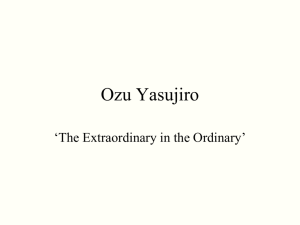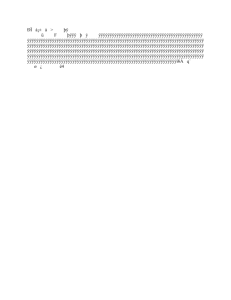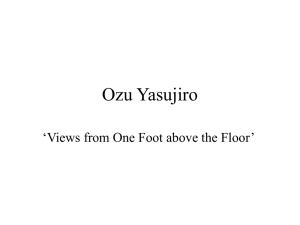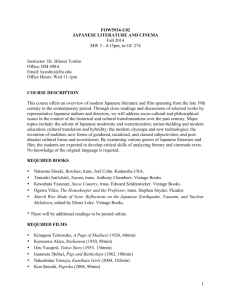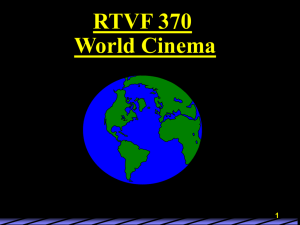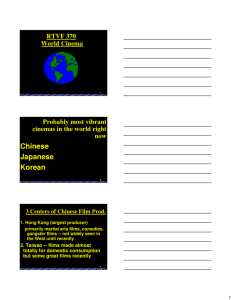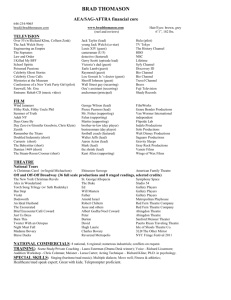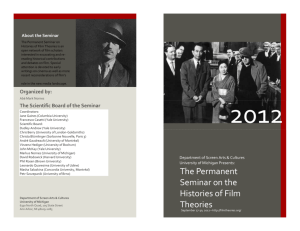Ozu Yasujiro
advertisement
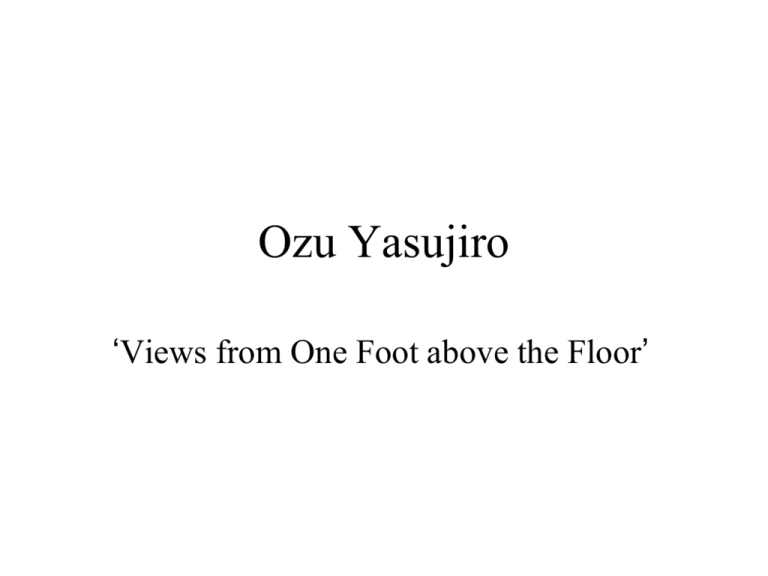
Ozu Yasujiro ‘Views from One Foot above the Floor’ Ozu as auteur • Complete control of filmmaking in every stage • The condition for being an auteur • Ozu wrote all his late scripts with Noda Kogo and gave meticulous and final instructions on the production design and photography to his crew (Ozu Gumi) members. Ozu as auteur Mr. Ozu looked happiest when he was engaged in writing a scenario with Mr. Kogo Noda, at the latter's cottage on the tableland of Nagano Prefecture. By the time he finished writing a script, after about four months’ effort, he had already made up every image in every shot, so that he never changed the scenario after we went on the set. The words were so polished up that he would not allow us even a single mistake. Ozu as auteur • Ozu had most of things in his head: set designs, locations, compositions, lighting, camera positions, camera movements, acting, length of shots, the ways in which film is cut • Once his style was established, he never changed it. • Distinctive stylization Ozu as auteur • Ozu-gumi (the Ozu crew) • His crew members hardly changed. Only possible in Japan’s studio system Ozu as auteur • Late Spring (1949) Producer: Yamamoto Takeshi Script: Ozu Yasujiro and Noda Kogo Camera: Atsuta Yuharu Editor: Hamamura Yoshiyasu Music: Ito Senji Art: Hamada Tatsuo • Tokyo Monogatari (1953) Producer: Yamamoto Takeshi Script: Ozu Yasujiro and Noda Kogo Camera: Atsuta Yuharu Editor: Hamamura Yoshiyasu Music: Saito Kojun Art : Hamada Tatsuo Ozu as auteur • Equinox Flower(1958) Producer: Yamamoto Takeshi Script: Ozu Yasujiro and Noda Kogo Camera: Atsuta Yuharu Editor: Hamamura Yoshiyasu Music: Saito Kojun Art: Hamada Tatsuo • Autumn Afternoon(1962) Producer: Yamanouchi Shizuo Script: Ozu Yasujiro and Noda Kogo Camera: Atsuta Yuharu Editor: Hamamura Yoshiyasu Music: Saito Kojun Art: Hamada Tatsuo Ozu as auteur • Photographer: Atsuta Yuharu • Atsuta was an assistant cameraman for Ozu for 6 years and his first photographer for 25 years from 1937 (What Did the Lady Forget?) to 1962. After Ozu’s death he did not work for any other director. Ozu as auteur • Ozu was the only director for whom Atsuta operated his camera. Atsuta had learned what Ozu wanted before he became the first cameraman and he did not need any instruction. • Complete grasp of Ozu’s intentions. • Tokyo-ga Ozu as auteur Though years’ experience as an assistant … I’ve learned what Ozu wanted. I didn’t bother to ask him about the camera position; Occasionally he said, “I don’t like to look down on people. A down shot makes me feel as though I’m looking down. So I like the camera on the horizontal.” -- Atsuta Yuharu Ozu as auteur Noda Kogo • He co-wrote with Ozu the 13 scripts of the 15 post-war films. • For Ozu the script is to a film director as the blueprint is to an architect. - Avoid ‘dramatic’ plots - Ordinary stories of ordinary people - Birth, growth, marriage, aging and death – ‘the wheel of life’ Ozu as auteur • Scripts written jointly by Ozu and Noda • Few instructions of action appeared on the scripts and no indications of shot sizes, angles, points of view, camera movements, lightings etc. Everything was already in Ozu’s head. Once a scenario is completed, not a single word is added or taken away (almost!) Ozu as auteur • Saito Kojun provided music for Ozu’s major postwar films. Tokyo Story, Early Spring, Tokyo Twilight, Equinox Flower, Floating Weed, Late Autumn, Autumn Afternoon • Light music style with restrained emotional appeal • Give the film distinctive mood and atmosphere Ozu as auteur Music from Tokyo Story Opening music of Late Autumn Ozu as auteur Title and credit scene Letters written in a writing brush against hemp cloth Ozu as auteur • • • • Hamamura Yoshiyasu Ozu’s editor for his major films Quiet editing One shot lasts from 2 seconds to 10 seconds: no extremely short or long • In the shot-reverse-shot, a shot is timed according to the length of dialogue • Tokyo Story, Autumn Afternoon 1, Autumn Afternoon 2 • Still-life shots in uniform length Ozu as auteur • Ozu kept using the same actors: Ryu Chishu, Hara Setsuko, Sugimura Haruko, Tanaka Kinuyo, Yamamura So, Nakamura Nobuo, Tono Eijiro • Ozu completely dictates the ways in which actors deliver dialogues and act, allowing them no freedom and improvisation. Ozu as auteur • Performers who appeared regularly in Ozu’s films understood his intentions and filming methods completely. Ozu as auteur • More regular faces in Ozu’s films. • Tanaka Kinuyo and Sugimura Haruko Ozu as auteur • Rigid, artificial action - lack of spontaneity (both strength and weakness) • Ozu won complete trust from actors • Stylized ‘beauty’ - sense of order Ozu operating the camera by himself Tokyo-ga interview of Atsuta Yuharu Ozu editing the film himself. Ozu directing performance Tokyo-ga interview of Ryu Chishu Ozu directing performance Ozu’s Visual Style (Mise-en-scène) Style derives from the consistent use of certain techniques. Mise-en-scène - Motionless camera - Low-level camera placement (one foot above the floor) - One lens (with focal length of 50mm, a slight telephoto, the focal length of the normal lens 35mm) Ozu’s Visual Style (Mise-en-scène) • The camera placed about one foot from the floor low level shots without moving the camera (no pans or travelling) • Only slight low-angle Ozu’s Visual Style (Mise-en-scène) - Horizontal composition c.f. Mizoguchi’s diagonal composition Ozu’s Visual Style (Mise-en-scène) • Composition - horizontal and (slight) low angle while Mizoguchi’s favourite composition is diagonal and high-angle Ozu’s Visual Style (Mise-en-scène) • Perspectival placement of a group of people • Careful, geometrical arrangement of screen Ozu’s Visual Style (Mise-en-scène) Ozu’s Visual Style (Mise-en-scène) • - Frontal composition: actors (almost) directly looking at and talking to the camera • Unconventional and against classic film making rules Ozu’s Visual Style (Mise-en-scène) • More frontal compositions Ozu’s Visual Style (Mise-en-scène) • More frontal composition Ozu’s Visual Style (Mise-en-scène) • Frontal compositions • Faces turned to the camera Ozu’s Visual Style (Mise-en-scène) Uniform set design • Middle-class Japanese household • Shoji (sliding paper door) wide open and shallow perspective with background view is partly blocked by a wall. Ozu’s Visual Style (Mise-en-scène) • More examples of Ozu’s favourite interior design • Empty tatami in foreground, figures in the middle ground and a small garden and wall at the background Ozu’s Visual Style (Mise-en-scène) • The same interior design consistently used Ozu’s Visual Style (Mise-en-scène) • Japanese architecture and horizontal composition • The camera’s straight-on, horizontal angle and low position creates horizontal composition. • Lack of depth - shallow composition Ozu’s Colour Films • The same mise-en-scéne is employed in colour films • Repeated uses of the same colour - red Ozu’s Colour Films Ozu’s Colour Films • Red is used in ‘pillow’ shots Ozu’s Visual Style (Montage) Montage (Editing) - Rhythmic editing (nearly fixed lengths of shots according to shot sizes and lengths of diaologues) ‘Ozu’s low camera position is not for long takes. It makes a rhythm from a combination of medium long shot, and reverse mediumlong shot. Consequently, how long one shot lasts becomes very important. - Cuts - no dissolve, fade or wipe Fade (in) Wipe Ozu’s Visual Style (Montage) • Almost perfect visual match in shot-and-reverseshots • Drinking sake from the cup held in the right hand; matching waistcoats and ties; the same hair-style; the pillar at their back on the screen right. Ozu’s Visual Style (Montage) • Even the position of the beer bottle is the same, on the right of each character and the label of the beer is facing to the camera in either shot. Ozu’s Visual Style (Montage) • ELLIPSIS - narrative device used in literature to leave out a (large) portion of an action, an event or situation. • Ozu frequently uses this device. • The viewer learns of important narrative events only after they have occurred. • Tokyo Story: The viewer does not see the grandmother falls ill - the viewer knows it only when her son and daughter receive a telegram; her death taking place between scenes: in one scene, they are at her bedside and in the next they are mourning her death Ozu’s Visual Style (Montage) - ‘Pillow shots’ or ‘still life shots’ which are not directly related with narratives and function as transitional insertions. Ozu’s Visual Style (Montage) • Pillow shot – an nondiegetic punctuation shot inserted between two sequences in Ozu’s films. • Inviting (philosophical) interpretations of their purpose and function. • Late Spring Ozu’s Visual Style (Montage) • Noriko gets a phone call at work telling that her mother-in-law is ill; medium shot of her at desk with sound of typewriters Ozu’s Visual Style (Montage) • Cut to a low-angle shot of a building under construction with riveting machine sounds and music Ozu’s Visual Style (Montage) • Cut to another shot of the construction site with the same sounds Ozu’s Visual Style (Montage) • Then a cut to Koichi’s clinic with his sister, Shige present. The new scene begins. Ozu’s Visual Style (Montage) • Meanings of pillow shot • Contemplative and aesthetic • Related to story-telling mechanism: frequent uses of ellipsis (a segment of a narrative is deliberately omitted) • Pillow shot indicates that an ellipsis occurs. Ozu’s Film Style Ignoring the standard continuity editing - 180 degree rule - Omission of the establishing shot - using space of 360 degrees Ozu’s Montage: the 180 degree rule Ozu comfortably ignores the 180 degree rule: a man drinking tea facing towards the frame right Ozu’s Montage: the 180 degree rule In the next shot, the man facing the frame left. A grave mistake in the classical montage style Meanings of Ozu’s visual style Restrained and minimalist cinematic style • Ozu’s film style is often compared to Zen - ‘Ozu’s simplicity of style derives from the fact that his art is essentially religious in nature. It is an art predicated on the Zen Buddhism…’ David A. Cook - Mystery of the everyday ‘… it is only through the mundane and the common that the transcendent can be expressed.’ Donald Ritchie Meanings of Ozu’s visual style - Contemplative and meditative quality; the expression of quietness, motionless, emptiness and nothingness Meanings of Ozu’s visual style • Empty frame – an action ends and an empty frame is left – great emotional resonance Meanings of Ozu’s visual style - Self-abandonment yielding to fate and destiny without conscious struggle - The tombstone of Ozu’s grave – ‘無’ Nothing Meanings of Ozu’s visual style • How much are Ozu’s images religious expression? • How closely are Ozu’s films related with Zen Buddhism and its spirit?
![[Lecture 13] Ozu 2012 for wiki](http://s3.studylib.net/store/data/009641384_1-e7542f19ec665385526e518c9ac9fbd0-300x300.png)
